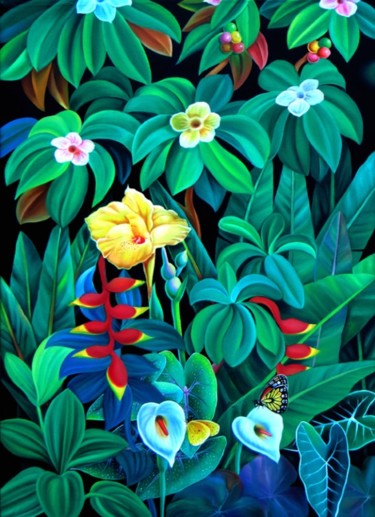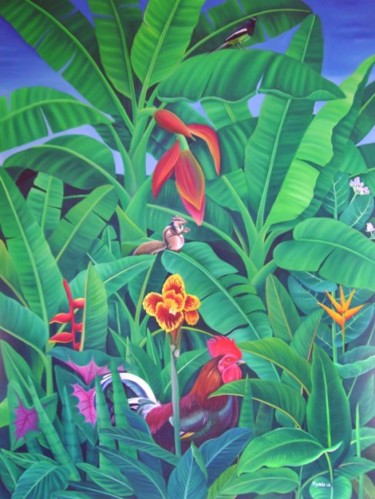Murali Nagapuzha
Pollock – Krasner Foundation
Grant of 6.58 lakh for
Murali Nagapuzha
New York: Murali Nagapuzha, a self taught artist from Kerala, India has been awarded the Pollock – Krasner Foundation grant of $ 14,000 [around 6.58 lakh rupees]. Murali rose to fame when his style of celebration of nature, was compared by critics with that of the French genious Henri Rousseau. Murali made a mark globally by indulging in the contours and colours of the Kerala – his home state which revels in greenery.
The grant is in recognition of the promise and indigenity shown by Murali Nagapuzha in a host of creations. Murali’s work was viewed and selected by a distinguished committee of art professionals, according to a letter from Charles C Bergman, Chairman of the foundation. The letter also requests Murali to convey, to artist colleagues, of the Foundation’s aims – to assist artists of merit who have financial need, and to encourage them to apply for grant. Details and application form are available at
The foundation also took into account references from artists and connoisseurs from across the world before selecting him for the grant. “Largely because of the exceptional quality of your work and the extent of your artistic achievement, you have been awarded a grant from the Pollock – Krasner foundation,” says a letter from Caroline Black, program Officer at the foundation.
In a reference sent to the foundation, Gerard Saby, former head of the French Cultural Centre in India, recalled an exhibition, ‘Of elephants, spices and the everyday’, organized by the centre. “The exhibition not only attracted a large audience of art lovers, critics, but also many people who had never been to a gallery. The success was tremendous, because I feel Murali is a singular voice in contemporary Indian art.
Gerard Saby also recalled novelist Anita Nair’s words: “Murali’s art works with sentiment but at no time are we to dismiss it as sentimental. It is vulnerable in that it allows itself to be perceived as childlike but that is its strength. A child’s innocence, a child’s lack of duplicity, a child like playfulness and a child’s wonder – the eternal sunshine of a spotless mind.”
Murali Nagapuzha, who is the son of a traditional bell metal worker, from Muvattupuzha in Ernakulam district of Kerala has over fifty exhibitons to his credit including nine solo shows across the world. His last show was at Santamonica, California in May this year. Noble Saga Gallery, London and Gallery Roman Rolland, New Delhi will host his solo exhibitions early next year.
For details: Murali Nagapuzha: +91 9446569743
Email:
profiles/profile-Murali-Nagapuzha.htm
Discover contemporary artworks by Murali Nagapuzha, browse recent artworks and buy online. Categories: contemporary indian artists. Artistic domains: Painting. Account type: Artist , member since 2006 (Country of origin India). Buy Murali Nagapuzha's latest works on ArtMajeur: Discover great art by contemporary artist Murali Nagapuzha. Browse artworks, buy original art or high end prints.

Artist Value, Biography, Artist's studio:
child hood • 3 artworks
View allalmost lost world • 26 artworks
View allnew works delhi show • 6 artworks
View allbirds • 13 artworks
View allnew works • 10 artworks
View allnew • 11 artworks
View allflowers • 10 artworks
View allnew works • 5 artworks
View allnative • 5 artworks
View alloil o canvass • 3 artworks
View allSold Artworks • 8 artworks
Recognition
Biography
Pollock – Krasner Foundation
Grant of 6.58 lakh for
Murali Nagapuzha
New York: Murali Nagapuzha, a self taught artist from Kerala, India has been awarded the Pollock – Krasner Foundation grant of $ 14,000 [around 6.58 lakh rupees]. Murali rose to fame when his style of celebration of nature, was compared by critics with that of the French genious Henri Rousseau. Murali made a mark globally by indulging in the contours and colours of the Kerala – his home state which revels in greenery.
The grant is in recognition of the promise and indigenity shown by Murali Nagapuzha in a host of creations. Murali’s work was viewed and selected by a distinguished committee of art professionals, according to a letter from Charles C Bergman, Chairman of the foundation. The letter also requests Murali to convey, to artist colleagues, of the Foundation’s aims – to assist artists of merit who have financial need, and to encourage them to apply for grant. Details and application form are available at
The foundation also took into account references from artists and connoisseurs from across the world before selecting him for the grant. “Largely because of the exceptional quality of your work and the extent of your artistic achievement, you have been awarded a grant from the Pollock – Krasner foundation,” says a letter from Caroline Black, program Officer at the foundation.
In a reference sent to the foundation, Gerard Saby, former head of the French Cultural Centre in India, recalled an exhibition, ‘Of elephants, spices and the everyday’, organized by the centre. “The exhibition not only attracted a large audience of art lovers, critics, but also many people who had never been to a gallery. The success was tremendous, because I feel Murali is a singular voice in contemporary Indian art.
Gerard Saby also recalled novelist Anita Nair’s words: “Murali’s art works with sentiment but at no time are we to dismiss it as sentimental. It is vulnerable in that it allows itself to be perceived as childlike but that is its strength. A child’s innocence, a child’s lack of duplicity, a child like playfulness and a child’s wonder – the eternal sunshine of a spotless mind.”
Murali Nagapuzha, who is the son of a traditional bell metal worker, from Muvattupuzha in Ernakulam district of Kerala has over fifty exhibitons to his credit including nine solo shows across the world. His last show was at Santamonica, California in May this year. Noble Saga Gallery, London and Gallery Roman Rolland, New Delhi will host his solo exhibitions early next year.
For details: Murali Nagapuzha: +91 9446569743
Email:
profiles/profile-Murali-Nagapuzha.htm
-
Nationality:
INDIA

- Date of birth : unknown date
- Artistic domains:
- Groups: Contemporary Indian Artists
Ongoing and Upcoming art events
Influences
Education
Artist value certified
Achievements
Activity on ArtMajeur
Latest News
All the latest news from contemporary artist Murali Nagapuzha
murali
Honours
National fellowship from ministry of humen resours India (I989) for Reaserch work kalamezhuthu
Kerala lailitha kala acadamy award 1992, 1995
Raja revi varma Birth centinery award 1998
Kerala chitra kala parishath honour
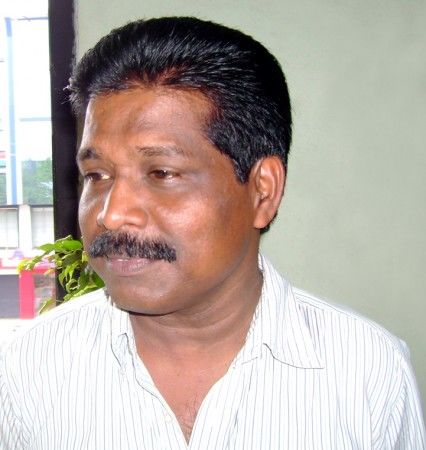
camps
CAMPS
Zonal camp Wyanad 1988
Stae artist camps Trissur 1989, 1990
National Camp ponmudi 1991
National Camp Kasargod 1996
National camp Munnar 1999
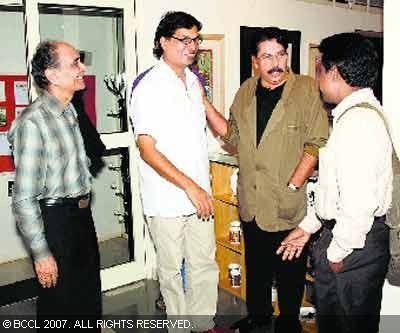
sunit chopra financial express
From Mumbai we have Atul Dodiya, Bal Chabda, Naina Dalal, Laxman Sreshta, Prabhakar Kolte, Jitish Kallat and Krishnamachari Bose. A new crop of artists is emerging in the South, as one can see from the considerable number of artists from Hyderabad, Kerala and Chennai. These include A Ramachandran, K G Subramanyan, B V Andani, Laxman Goud, T Vaikuntam, Valsan Kalleri, Nandagopal, Balasubramaniam, Murali Nagapuzha, Ramesh Gorjala, Babu Xavier, Shijo Jacob, Karl Antao, Akkitham Narayanan, Rinzon, Harsha, T V Santhosh and Jyothi Basu, whose work has been seen in different parts of the country recently.
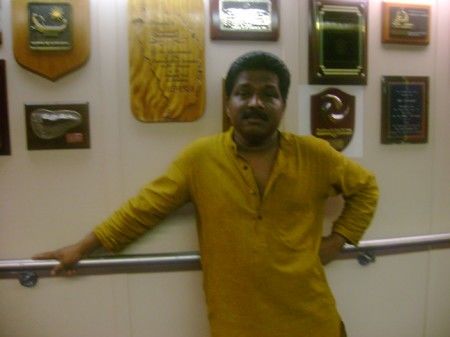
hindu coimbatore
Lure of a forgotten world
Muraly Nagapuzha's paintings take you into a world of childhood innocence, alluring natural beauty and fanciful dreams
old man and the sea: Muraly Nagapuzha's fishermen series is a peek into an earthy way of life. Photos: k. ananthan
Lush greenery, little butterflies dancing on greenish-yellow leaves, bees sucking on a blooming lotus, the haunting quiescence of an ancestral home ... artist Muraly Nagapuzha's paintings seek to touch and awaken long forgotten childhood memories and tempt you with the bewitching beauty of nature.
For all of us caught in the web of city life, where young ones are more at ease fiddling with gadgets than spotting a caterpillar, the collection on display at the Kasthuri Sreenivasan Trust Culture Centre on Avanashi Road will make you pause, re-wind and recollect those summer holidays at your grandmother's house spent chasing an unruly calf or wading through slush to pluck out that half-open lotus.
In nature's lap
"Nature is a predominant theme in my paintings. I come from a village in Kerala where life is about small things, the butterfly and the cows, of children playing hide and seek and going fishing. It is the simplicity of village life which I have tried to capture here," says the artist about his eighth solo show.
An idealistic vision where man, beast and birds exist in harmony is splashed in colours by Nagapuzha.
`Colours of Joy' besides traversing the charms of the country, also portrays struggles, like Nagapuzha's Tirunelli series. The virgin beauty of Tirunelli and the identity of the adivasis, which cannot be severed from their land, is poignantly captured in some of his paintings.
Another subject close to the artist is children, who are his inspiration as well as theme. "Children fascinate me and these paintings are, to a certain extent, aimed at them. They need to be initiated to the minute facets of nature," says Nagapuzha, whose childhood and dream series takes us into the world of winged angels, colourful flowers and fancy flights.
The sea and I
His fishermen series is much more than a hobby arrested in colours; it's a peek into an earthy way of life.
"For me, the whole act of dangling the bait and waiting takes you to a state of being which is beyond yoga and meditation," Nagapuzha recounts.
The artist, who is inspired by the legendary Bhupen Kakkar, also makes a flight into fantasy with his sleep and myth series. Nagapuzha has tried to weave legends and tales into his paintings on fantasy. Also on display is the floral series as well as portraits of tribal women.
"In this age of universalisation, I wish to highlight ethnicity, our specific identity and our culture," he says.
The exhibition is on till June 13 and will be open from 10 a.m. to 7 p.m. All paintings are for sale. For details, call 0422-2574110.
ANIMA BALAKRISHNAN
Printer friendly page
Send this article to Friends by E-Mail
Metro Plus Bangalore Chennai Coimbatore Delhi Hyderabad Kochi Madurai Mangalore Pondicherry Tiruchirapalli Thiruvananthapuram Vijayawada Visakhapatnam
Features: Magazine | Literary Review | Life | Metro Plus | Open Page | Education Plus | Book Review | Business | SciTech | Entertainment | Young World | Property Plus | Quest | Folio |
Archives
Datewise
Classified
Lead
Life Style
Fashion
Music
Personality
Eating Out
Madras Miscellany
Issues
Arts & Crafts
Information Technology
Shopping
Heritage
Miscellany
News
News Update
Front Page
National
States:
• Tamil Nadu
• Andhra Pradesh
• Karnataka
• Kerala
• New Delhi
• Other States
International
Opinion
Business
Sport
Miscellaneous
Index
--------------------------------------------------------------------------------
The Hindu Group: Home | About Us | Copyright | Archives | Contacts | Subscription
Group Sites: The Hindu | Business Line | The Sportstar | Frontline | The Hindu eBooks | The Hindu Images | Home |
Comments to : Copyright © 2005, The Hindu
Republication or redissemination of the contents of this screen are expressly prohibited without the written consent of The Hindu
--------------------------------------------------------------------------------
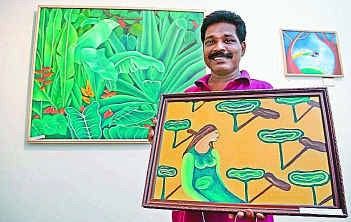
hindu sunday by kk gopalakrishnan
ART
Colours of joy
Famous for his Basheer and Thirunelli series, Murali Nagapuzha now focuses on nature and greenery. K.K. GOPALAKRISHNAN profiles the self-taught eco-friendly painter.
Nagapuzha's works follow an inner call.
ART critics and media first noticed Murali Nagapuzha in the early 1980s, with his series of paintings on the characters of noted Malayalam litterateur Vaikom Mohammed Basheer. These paintings were remarkably accurate in their portrayal of the stories' mood and marked a turning point in Nagapuzha's artistic life.
Emergency's shocks
The 1980s saw a revolution in the artistic endeavour of young painters in Kerala. The Emergency (1975-77) was an underlying current. The silence of Indian intellectuals, whom Nagapuzha considered role models, during the Emergency shocked him and later forced him into the interior villages of Kerala. There were no newspapers or radio — no contact with the outside world. His only company was books, the villagers, and the rich folk arts.
During the Emergency, Nagapuzha was in college. He led protests and demands for fundamental rights. On several occasions, the police raided his house, threatened his mother and siblings, but the villagers and some of the faculty protected him. The police arrested his friend, Aziz, who had helped him design and put up posters. Aziz died a week after his release from unofficial police custody. Nagapuzha is yet to recover from the shock of Aziz's death.
Suppose the Emergency had not happened? "I would have been a journalist, perhaps a photojournalist, or may be a clerk in government service or a teacher in the village school in Muvattupuzha of Ernakulam district," says Nagapuzha. He believes that it was his frustration with the silence of the Indian intellectuals, artists and writers during the Emergency that led him to escape into himself.
He now lives "fairly well as a freelance painter based in Kerala". He was also the editor of a popular children's magazine in Malayalam, promoted by the Desabhimani daily.
Why did he choose to leave that job? "Other than painting and reading I spent time with kids. My time underground brought me closer to kids... children of my friends... and now my daughter too... But I was unable to deal with my job and the innocent notions of kids. By the time our kids are four or five, the majority of them start losing their innocence. They talk the way they are taught by their parents and tuition teachers. They want toy AK-47s and stories of bomb blasts or aeroplane crashes not stories of monkey or a lullaby."
Turning point
Inspired by Nature ... Nagapuzha.
Time has proved that his decision was not wrong. A few years ago, when the Lalit Kala Akademi exhibited select paintings, a five-year-old girl identified a portrait from his famous Thirunelli series as her grandmother. Until the exhibition was over, the girl came every day to see this particular portrait. "I was sorry that I could not meet the girl and give it to her. "
After the Basheer and Thirunelli series, there was another remarkable turning point in his creative work. Leaves, flowers and greenery dominated his work. His paintings are eco-friendly and give the viewer a sense of joy. Though the painter has haunting memories and bad experiences, his paintings leave the viewer with a feeling of contentment and would never know of the artist's emotional strife. "The joy that I get from being with kids, the solace I get from nature, villages and our folk arts, I try to transfer to my viewers and buyers," explains Nagapuzha. "I believe that an artist should not exude his agonies and nightmares to his viewers. If possible give them some comfort, after all our life span is too little."
What is his main advantage as a painter? "I don't belong to any school. I am self-taught and self-made. Therefore, I have only my inner call to follow; need not rebel to substantiate a school or support a style."
Nagapuzha was the first recipient of the coveted Raja Ravi Varma award, instituted in 1998. The Kerala Lalit Kala Akademi honoured him with the State award in 1993 and 1997.
Printer friendly page
Send this article to Friends by E-Mail
Magazine
Features: Magazine | Literary Review | Life | Metro Plus | Open Page | Education Plus | Book Review | Business | SciTech | Entertainment | Young World | Property Plus | Quest | Folio |
The Hindu National Essay Contest Results
Archives
Datewise
Issues
Cuisine
Travel
Gardening
News
News Update
Front Page
National
States:
• Tamil Nadu
• Andhra Pradesh
• Karnataka
• Kerala
• New Delhi
• Other States
International
Opinion
Business
Sport
Miscellaneous
Index
--------------------------------------------------------------------------------
The Hindu Group: Home | About Us | Copyright | Archives | Contacts | Subscription
Group Sites: The Hindu | Business Line | The Sportstar | Frontline | The Hindu eBooks | Home |
Comments to : Copyright © 2004, The Hindu
Republication or redissemination of the contents of this screen are expressly prohibited without the written consent of The Hindu
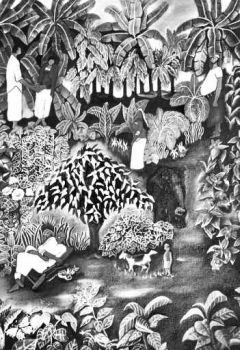
Article
CURRENT ISSUE MAY 08, 2006
YOUR WEEK: ARTS & ENTERTAINMENT
ART
A Human Nature
PICTURE SPEAK
Paintings by Murali Nagapuzha
DELHI: Here is an exhibition that should lift your spirits. Putting aside her cerebral and post-modernist concerns, Alka Pande-easily the most active art curator in the country-brings to the capital the wondrous works of the not-so-well-known Kerala painter Murali Nagapuzha. This 47-year-old, self-taught artist first attracted attention two decades ago with his epochal paintings of Basheer With His Characters, a whimsical tribute to Vaikom Muhammed Basheer, the renowned Malayalam writer and novelist.
At first glance, with his celebration of nature in depiction of a naive verdant idyll, Nagapuzha's style is rather reminiscent of that of the French (also self-taught) genius Henri Rousseau (1844-1910).
But that would be a facile observation. For unlike Rousseau, Nagapuzha populates his idyll with a narrative that is located in his own experience. Whereas the French painter had to conjure up his tropicalised landscapes from his imagination to the extent that they fell in the realm of what was later termed as surrealism by European admirers, Nagapuzha, living in lush rural Kerala, had only to look out of his window to be inspired. As Pande put it: "He did remind me a bit of Rousseau in the lushness of his landscape, but what was startling was the way he presented humans in his works. Besides, his mastery over the medium, the play of fantasy and the sensuality of painting was simply entrancing." A must-see show, on at the Galerie Romain Rolland, 72 Lodi Estate, from May 4 to13.
-By S. Kalidas
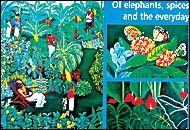
hindu delhi/ madhur tangha
NEW DELHI: He derives inspiration from his tranquil village in God's Own Country. No wonder life in rural Kerala comes alive in artist Murali Nagapuzha's works. His latest exhibition of paintings, "Of Elephants, Spices and the Everyday", displaying his earlier and recent works opens at Galerie Romain Rolland in South Delhi on May 4.
Organised by Alliance Francaise de Delhi, with support from the Office of Trade Promotion of the Embassy of Poland and the Travancore Art Gallery, the exhibition will feature about 40 works of the self-taught artist.
Murali's paintings set in his birthplace Muvattupuzha reflect the atmosphere he grew up in. Strongly influenced by the colours of nature, rich traditional and mythological heritage, his paintings have a dream-like quality about them.
"In a highly polluted and contaminated environment where even a lungful of air is a rarity, I try to depict the tranquillity of a bygone village in Kerala," says Murali.
His rural background and absence of formal training from any school of painting came as a blessing in disguise as he evolved a style all his own.
Curated and presented by Alka Pande, the exhibition will be on view up to May 13.
Printer friendly page
Send this article to Friends by E-Mail
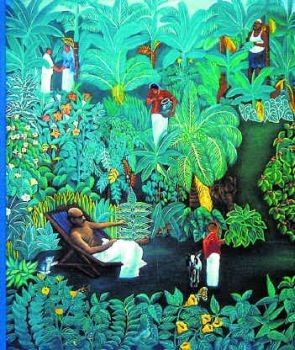
web search
Web Results 1 - 10 of about 1,540 for murali nagapuzha. (0.11 seconds)
Tip: Save time by hitting the return key instead of clicking on "search"
Search ResultsMurali Nagapuzha: Indian Contemporary Artist, Oil on CanvasOn IndianArtCollectors you can buy Indian Contemporary Art directly from artists like Murali Nagapuzha.
artistname.php?aid=1343 - 74k - Cached - Similar pages
:: Murali Nagapuzha ::Native SeriesMurali Nagapuzha. Native Series. Size(in inches), 12X16. Medium, Oil on Canvas. Year, 2008 ... Artwork Acquired through IndianArtCollectors. Murali Nagapuzha.
view-details.php?arid=24456 - 6k - Cached - Similar pages
Murali NagapuzhaDiscover the artworks of international artist murali Nagapuzha.
?go=user_pages/display_all&login=nagapuzha - 26k - Cached - Similar pages
Murali Nagapuzha - Life on the Corner - a profile by Anita NairTo understand Murali Nagapuzha’s art, we need to first look at Kerala. ... So this then is the world of Murali Nagapuzha. Part memory. Part nostalgia. ...
profiles/profile-Murali-Nagapuzha.htm - 14k - Cached - Similar pages
Artiforus Art Galleries- Art collections of Famous Artists, A Fine ...Present Collections more>> · home · Artist Biography · media · NEWS & ARTICLES · contact us. murali nagapuzha. © ARTIFORUS,2008.
murali.htm - 8k - Cached - Similar pages
The Hindu : Magazine / Arts & Crafts : Life on the corner27 May 2007 ... Murali Nagapuzha’s artistic motifs are drawn from a landscape that is now part of every tourist brochure that celebrates God’s Own Country. ...
mag/2007/05/27/stories/2007052750030200.htm - 24k - Cached - Similar pages
Murali Nagapuzha Artist-Rameshwar Singh Art Gallery,Rameshwar ...Rameshwar Singh Artist- rameshwar singh art gallery, rameshwar singh paintings, rameshwar singh's art gallery, indian rameshwar singh artist, ...
artist-murali-nagapuzha.html - 13k - Cached - Similar pages
Murali Nagapuzha :: Saatchi Online - Show your art to the world - [ Translate this page ]Murali Nagapuzha Nicolas Bourriaud, Director of Tate Gallery, London, refers to his work “as naïve and pantheistic representations tes.
www.saatchi-gallery.co.uk/yourgallery/artist_profile/Murali+Nagapuzha/12159.html - 107k - Cached - Similar pages
Artist Profile - SaffronArt :: Murali NagapuzhaMurali Nagapuzha. Currently there is no artist profile available for the selected artist. View works in: Browse & Buy Exhibitions Auctions. Ref 20406 ...
artist/artistprofile.aspx?artistid=2332&a=Murali%20%20Nagapuzha - 48k - Cached - Similar pages
AG34 cv Murali Nagapuzhaportfolio by Murali Nagapuzha. ... Muraly Nagapuzha is hailed as one of the very few outstanding painters of India among the new generation. ...
cv.India-muralinagappuzha.htm - 7k - Cached - Similar pages

biodata
Murali Nagapuzha
Native of Muvattupuzha, Ernakulam district, Kerala .India
Self taught Artist
Educational Qualification
B.Sc (Zoology
Permanant address
Murali Nagapuzha
S4 . Menachery Apartments, Bishop Palace Road
Chembukkave, Trissur. Kerala state.
. 680020 pin
Ph. 09446569743 /
Son of a traditional bell metal worker
Honours and Awards
1986 National fellowship from Ministry of Human Resourses. Govt. of India for research work. Kalamezhuthu. Tradtional floral painting in Kerala.
1992 Kerala Lailitha Kala Acadamy Award.Highly commended certificate
1995 Kerala Lalithakala Academy Award.Highly commended certificate
2010 Jackson pollck Krasner grant
1998 Raja Ravi Varma Birth Centenary Award. Kilimanoor
GROUP Exhibitions.
Kerala Lalitha Kala Acadamy Annual shows 1985,86,87, 88,89,90,91, 92, 93, 2002,2003,2004
2003 AIFACS New Delhi Show. Contemporary Art Gallery Kochi.
1993 Kelakam, Kannur, Sponsored by Kerala Lalitha Kala Acadamy
1997 National exhibition by National Lalitha Kala Acadamy Bangalore
2004 Apparao Galleries .Triveni Kala Sangam New Delhi
2004 Gallery East, New York
2005 Colors of Joy . Chitrasala Thrissur. Sponsored by Kerala Lailitha Kala Academy
2005 Kerala Lalitha Kala acadamy. Show in aid of Tsunami victims Kochi, Trivandrum
2005 Turning the wheel. Traditions unbound . Cntemporarary to past Curated by Dr. .Alka Pande Visual Art Gallery, Habitat Centre New Delhi, Sponsored by United Nations.
2007 Triveda Fine Arts, Early to Contemporary, New Delhi .Oberoi hotel. Ball room
2007 National Gallery of Modern Art. Moscow. Contemporary Indian Art in 21st Century.25 Indian artists Curetted by David Baurriard London. Sponsored by Indian Embassy.
2008 Triveda fine art Ltd. Indian Art, Early to Contemporary. New Delhi .Sheraton Hotel. Ball room
2007 A selection of Indian Contemporary Art. The Art of Investment Ashvita Galleries Chennai ,and Coimbatore.
2008 Red Earth Monsoon Festival. New Delhi
2009 Cross Country. National Exhibition of Art, Travancore Art Gallery. New Delhi
2009 Seeing is Believing. India Consortium Project Gallerie New Delhi
2009 Beating heart of Kerala. Contemporary Art from gods own country Gallery Noble Saga. London
2009 Contemporary art for home. Lalith Asok Bangalore. Gallery Time and space
2009 Nove. First Impressions .A celebration of contemporary south Asian art .Indian Embassy .Muscat..Art Select gallery .Dubai
2010 Verse on canvass.. Acadamy of Fine Arts Kolkota Cureted by Buddhadev Mandal
2011 MAY I to 8 l south asian show Santamonica California
Poster and collage exhibitions In all city centers of Kerala on various social issues
Solo Exhibitions
1991 Mahatma Gandhi Mandir Kannur Sponsored by Kerala Lalitha Kala Acadamy,
1995 Life scapes sponsored by Cube kannur
2002 Joy of colors Lalitha kala academy Contemporary art gallery. Kochi
2003 Chitrasala Thrissur sponsored by lalitha kala acadamy.
2004 Yousef gallery, Mattanchery Kochi.
2004 Kerala lalitha kala acadamy Gallery Calicut .Colors of joy .Sponsored by Bank mens club
2005 Kasthuri Sreenivasan Trust Art Gallery .Coimbatore. Sponsored by KS trust
2006 Galleria Roman Rolland New Delhi .Of Elephants Spices and Everyday .Sponsors’ Alliance Francaise.New Delhi ,Embassy of Poland and State Government of Kerala, Cureted by Dr,Alka Pande
2007 Garden of Eden.Visions from Kerala Taj Gate way hotel .Bangalore. Celebration series. Cureted by Jayamony Ambara Sponsored by Taj Residency
2011 INDIAN EMBASSY MUSCAT
2012 HABITAT CENTRE NEW DELHI
Collections.
Kapurthala house New Delhi..Premiere Fine Yarns Coimbatore, Galleria New Delhi, Embassy of Poland New Delhi..Indian Embassy Muscat. Alliance Francaise New Delhi, Triveda Gallery New Delhi. Mianaz Gallery New Delhi. Indian Embassy Beijing .Indian Embassy Doha.. Ambara gallery. Bangalore. Time and space. Bangalore. Sumukha Gallery Bangalore. Renaissance Gallerie. Bangalore. Ambara Gallery Bangalore. Indecomm Global Services. Bangalore. Gallery soul flower .Banghok .The Noble Sage Gallery. London...Art Select Dubai. Neeleswar Hermitage. Kerala..DC. Books Kottayam, The studio. New Delhi, Imitiara Consultants Pvt. Ltd. New Delhi .State Bank of India Kannur, State Bank of India Thrissur.., Galleria New Delhi, and in many other private collections in India and abroad.

pollock krasener grant
Pollock – Krasner Foundation
Grant of 6.58 lakh for
Murali Nagapuzha
New York: Murali Nagapuzha, a self taught artist from Kerala, India has been awarded the Pollock – Krasner Foundation grant of $ 14,000 [around 6.58 lakh rupees]. Murali rose to fame when his style of celebration of nature, was compared by critics with that of the French genious Henri Rousseau. Murali made a mark globally by indulging in the contours and colours of the Kerala – his home state which revels in greenery.
The grant is in recognition of the promise and indigenity shown by Murali Nagapuzha in a host of creations. Murali’s work was viewed and selected by a distinguished committee of art professionals, according to a letter from Charles C Bergman, Chairman of the foundation. The letter also requests Murali to convey, to artist colleagues, of the Foundation’s aims – to assist artists of merit who have financial need, and to encourage them to apply for grant. Details and application form are available at
The foundation also took into account references from artists and connoisseurs from across the world before selecting him for the grant. “Largely because of the exceptional quality of your work and the extent of your artistic achievement, you have been awarded a grant from the Pollock – Krasner foundation,” says a letter from Caroline Black, program Officer at the foundation.
In a reference sent to the foundation, Gerard Saby, former head of the French Cultural Centre in India, recalled an exhibition, ‘Of elephants, spices and the everyday’, organized by the centre. “The exhibition not only attracted a large audience of art lovers, critics, but also many people who had never been to a gallery. The success was tremendous, because I feel Murali is a singular voice in contemporary Indian art.
Gerard Saby also recalled novelist Anita Nair’s words: “Murali’s art works with sentiment but at no time are we to dismiss it as sentimental. It is vulnerable in that it allows itself to be perceived as childlike but that is its strength. A child’s innocence, a child’s lack of duplicity, a child like playfulness and a child’s wonder – the eternal sunshine of a spotless mind.”
Murali Nagapuzha, who is the son of a traditional bell metal worker, from Muvattupuzha in Ernakulam district of Kerala has over fifty exhibitons to his credit including nine solo shows across the world. His last show was at Santamonica, California in May this year. Noble Saga Gallery, London and Gallery Roman Rolland, New Delhi will host his solo exhibitions early next year.
For details: Murali Nagapuzha: +91 9446569743
Email:
profiles/profile-Murali-Nagapuzha.htm
pollock krasener grant
Pollock – Krasner Foundation
Grant of 6.58 lakh for
Murali Nagapuzha
New York: Murali Nagapuzha, a self taught artist from Kerala, India has been awarded the Pollock – Krasner Foundation grant of $ 14,000 [around 6.58 lakh rupees]. Murali rose to fame when his style of celebration of nature, was compared by critics with that of the French genious Henri Rousseau. Murali made a mark globally by indulging in the contours and colours of the Kerala – his home state which revels in greenery.
The grant is in recognition of the promise and indigenity shown by Murali Nagapuzha in a host of creations. Murali’s work was viewed and selected by a distinguished committee of art professionals, according to a letter from Charles C Bergman, Chairman of the foundation. The letter also requests Murali to convey, to artist colleagues, of the Foundation’s aims – to assist artists of merit who have financial need, and to encourage them to apply for grant. Details and application form are available at
The foundation also took into account references from artists and connoisseurs from across the world before selecting him for the grant. “Largely because of the exceptional quality of your work and the extent of your artistic achievement, you have been awarded a grant from the Pollock – Krasner foundation,” says a letter from Caroline Black, program Officer at the foundation.
In a reference sent to the foundation, Gerard Saby, former head of the French Cultural Centre in India, recalled an exhibition, ‘Of elephants, spices and the everyday’, organized by the centre. “The exhibition not only attracted a large audience of art lovers, critics, but also many people who had never been to a gallery. The success was tremendous, because I feel Murali is a singular voice in contemporary Indian art.
Gerard Saby also recalled novelist Anita Nair’s words: “Murali’s art works with sentiment but at no time are we to dismiss it as sentimental. It is vulnerable in that it allows itself to be perceived as childlike but that is its strength. A child’s innocence, a child’s lack of duplicity, a child like playfulness and a child’s wonder – the eternal sunshine of a spotless mind.”
Murali Nagapuzha, who is the son of a traditional bell metal worker, from Muvattupuzha in Ernakulam district of Kerala has over fifty exhibitons to his credit including nine solo shows across the world. His last show was at Santamonica, California in May this year. Noble Saga Gallery, London and Gallery Roman Rolland, New Delhi will host his solo exhibitions early next year.
For details: Murali Nagapuzha: +91 9446569743
Email:
profiles/profile-Murali-Nagapuzha.htm
Pollock Krasener grant
Pollock – Krasner Foundation
Grant of 6.58 lakh for
Murali Nagapuzha
New York: Murali Nagapuzha, a self taught artist from Kerala, India has been awarded the Pollock – Krasner Foundation grant of $ 14,000 [around 6.58 lakh rupees]. Murali rose to fame when his style of celebration of nature, was compared by critics with that of the French genious Henri Rousseau. Murali made a mark globally by indulging in the contours and colours of the Kerala – his home state which revels in greenery.
The grant is in recognition of the promise and indigenity shown by Murali Nagapuzha in a host of creations. Murali’s work was viewed and selected by a distinguished committee of art professionals, according to a letter from Charles C Bergman, Chairman of the foundation. The letter also requests Murali to convey, to artist colleagues, of the Foundation’s aims – to assist artists of merit who have financial need, and to encourage them to apply for grant. Details and application form are available at
The foundation also took into account references from artists and connoisseurs from across the world before selecting him for the grant. “Largely because of the exceptional quality of your work and the extent of your artistic achievement, you have been awarded a grant from the Pollock – Krasner foundation,” says a letter from Caroline Black, program Officer at the foundation.
In a reference sent to the foundation, Gerard Saby, former head of the French Cultural Centre in India, recalled an exhibition, ‘Of elephants, spices and the everyday’, organized by the centre. “The exhibition not only attracted a large audience of art lovers, critics, but also many people who had never been to a gallery. The success was tremendous, because I feel Murali is a singular voice in contemporary Indian art.
Gerard Saby also recalled novelist Anita Nair’s words: “Murali’s art works with sentiment but at no time are we to dismiss it as sentimental. It is vulnerable in that it allows itself to be perceived as childlike but that is its strength. A child’s innocence, a child’s lack of duplicity, a child like playfulness and a child’s wonder – the eternal sunshine of a spotless mind.”
Murali Nagapuzha, who is the son of a traditional bell metal worker, from Muvattupuzha in Ernakulam district of Kerala has over fifty exhibitons to his credit including nine solo shows across the world. His last show was at Santamonica, California in May this year. Noble Saga Gallery, London and Gallery Roman Rolland, New Delhi will host his solo exhibitions early next year.
For details: Murali Nagapuzha: +91 9446569743
Email:
profiles/profile-Murali-Nagapuzha.htm
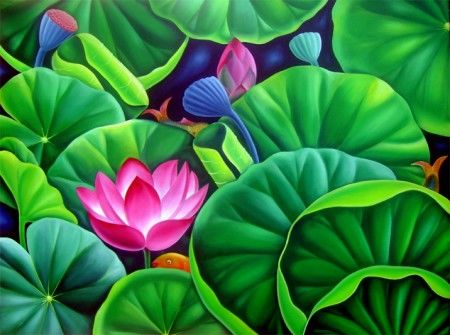
Article
Ms. Anita Nair's TEXT
Ms. Anita Nair's TEXT
"Anybody who tries from the start to make "universal" art is making a big mistake. That is the problem with international art today. That type of art moves just a very small group of people who, in some way, are trying to do the same thing. All great art that exists started out parochial. For example the Impressionists did not paint France; they painted some part of France; Montmartre, Montparnasse, cafe life. That was not an interpretation of European life, but simply life on the corner. Assyrian art represented the local reality--men hunting lions. Egyptian art showed everyday life. Everything has to start at the beginning, and that beginning is completely local. It's the same thing in literature."- Botero
To understand Murali Nagapuzha, we need to first look at Kerala. Where everyday is a painting. Waiting to be absorbed, distilled and captured.
The sun hangs a whole golden orb in the eastern sky. The wind crackles through the trees and the breeze nudges the undergrowth. The leaves of the palm trees snap. Tear drop leaves rain down from the tamarind trees.
Then there are the fields. Yellow stacks of paddy lie supine on the brown thirsty earth where once they stood green and erect waving their stubbly heads to the gods above.
The tiny mango. Chakkra-kutty. Sweet little thing. You puncture a hole in its skin with your teeth and suck its juice. The mouth is flooded with a sweetness with an aftertaste of wood ash. The yellow of sweetness with an ash belly.
Jack fruits chopped open. The pods drip with honey. Sweetness that glut the belly.
Golden bananas. Huge branches are strung up in shop fronts.
Flowers everywhere. Balsam and hibiscus. Yellow trumpet shaped flowers and tiny ‘ari-poo’ in the hedges. Marigolds. Rajakiredam. Thechi…
Ants scurry. Dragon flies hover. Giant ones with bead like eyes, a red and yellow body and gauzey wings. When hordes of them fly close to the land, it will rain that day, folklore says.
The bamboo cutters arrive. Chopping at the branches. Strangling the bamboo music with the heavy staccato rhythm of the axe.
Clouds gather and move up the coast. The skies darken. Lightening and thunder. The bars of heat loosen and with its first drops a deep dank fragrance. Moist earth laden with the memories of sun baked days and crumbling surfaces. The wetness of rain. The wetness of release.
Fireflies glow. A hair ornament? Could a man bedeck a lover with fireflies?
The night skies are lit up with the moon. The stars don’t twinkle in the moon light.
So this then is the world of Murali Nagapuzha. Part memory. Part nostalgia. Part a deep abiding love for the wonder of the everyday. Add to this the man that Murali is. A composite of many experiences that turned the indignant scrutiny of the conscientious being into an indefinable lode of artistry. When these come together, the world that disturbs Murali Nagapuzha and the world that he has an intimate understanding of and identification with is amalgamated and absorbed to create a whole new artistic dialect.
In this dialect, the vowels are less rounded and the consonants independent. Pause at the childhood series – where in a bucolic setting children frolic and a cow grazes. The hues of the hibiscus and the variegated leaves of the elephant yam are all familiar. Endearing images echoing with the poignancy of nostalgia. We all know that feeling but then what takes the breath away is the washing line of whiter than white clothes where a brassiere fluttering in the breeze is inserted with a certain and casual cheekiness. Never was art more alive and more resolute.
We see this again and again even as angels hover offering excess and more excess to a landscape already saturated with excess or as fish ache to bite and be part of that already laden fisherman’s catch.
As with the cadences of a new dialect that builds itself on the solid syntax of a much used language, Murali Nagapuzha’s work has the resonance of familiarity. We think we know and that we recognize it. Only at first. Murali uses the familiar to entice the eye. Then it is Murali’s world we are privy to. In the Basheer series we are first introduced to the Basheeresque motifs: goats and wondering little boys in ‘half trousers’, clandestine meetings and an ‘umma’ and ‘moplah’ -all positioned in the background while in the foreground Basheer in his armchair waits. This is a Basheer who like Murali draws from the familiar rather than concoct the new. It is both biography and artistic philosophy.
Murali Nagapuzha’s art works with sentiment but at no time are we to dismiss it as sentimental. It is vulnerable in that it allows itself to be perceived as childlike but that is its strength. A child’s innocence, a child’s lack of duplicity, a child like playfulness and a child’s wonder – ‘the eternal sunshine of a spotless mind’-.
In a world, where being accessible is considered being popular and hence less worthy, Murali Nagapuzha takes a risk. Not just is his realm figurative but his artistic motifs are drawn from a landscape that is now part of every tourist brochure. And yet, without being banal or kitschy, Murali Nagapuzha’s artistic terrain marvels at the Kerala contours and colours and makes it his own. To follow Murali there is be enchanted. It cuts off all escape routes and makes it impossible for us to turn away from his mindscape.
What more could an artist aspire for?
Anita Nair is the author of the best selling novels The Better man and Ladies Coupe. Her new novel is Mistress. Her books have been translated into over 25 languages across the world. Visit her at
Ms. Anita Nair's TEXT
"Anybody who tries from the start to make "universal" art is making a big mistake. That is the problem with international art today. That type of art moves just a very small group of people who, in some way, are trying to do the same thing. All great art that exists started out parochial. For example the Impressionists did not paint France; they painted some part of France; Montmartre, Montparnasse, cafe life. That was not an interpretation of European life, but simply life on the corner. Assyrian art represented the local reality--men hunting lions. Egyptian art showed everyday life. Everything has to start at the beginning, and that beginning is completely local. It's the same thing in literature."- Botero
To understand Murali Nagapuzha, we need to first look at Kerala. Where everyday is a painting. Waiting to be absorbed, distilled and captured.
The sun hangs a whole golden orb in the eastern sky. The wind crackles through the trees and the breeze nudges the undergrowth. The leaves of the palm trees snap. Tear drop leaves rain down from the tamarind trees.
Then there are the fields. Yellow stacks of paddy lie supine on the brown thirsty earth where once they stood green and erect waving their stubbly heads to the gods above.
The tiny mango. Chakkra-kutty. Sweet little thing. You puncture a hole in its skin with your teeth and suck its juice. The mouth is flooded with a sweetness with an aftertaste of wood ash. The yellow of sweetness with an ash belly.
Jack fruits chopped open. The pods drip with honey. Sweetness that glut the belly.
Golden bananas. Huge branches are strung up in shop fronts.
Flowers everywhere. Balsam and hibiscus. Yellow trumpet shaped flowers and tiny ‘ari-poo’ in the hedges. Marigolds. Rajakiredam. Thechi…
Ants scurry. Dragon flies hover. Giant ones with bead like eyes, a red and yellow body and gauzey wings. When hordes of them fly close to the land, it will rain that day, folklore says.
The bamboo cutters arrive. Chopping at the branches. Strangling the bamboo music with the heavy staccato rhythm of the axe.
Clouds gather and move up the coast. The skies darken. Lightening and thunder. The bars of heat loosen and with its first drops a deep dank fragrance. Moist earth laden with the memories of sun baked days and crumbling surfaces. The wetness of rain. The wetness of release.
Fireflies glow. A hair ornament? Could a man bedeck a lover with fireflies?
The night skies are lit up with the moon. The stars don’t twinkle in the moon light.
So this then is the world of Murali Nagapuzha. Part memory. Part nostalgia. Part a deep abiding love for the wonder of the everyday. Add to this the man that Murali is. A composite of many experiences that turned the indignant scrutiny of the conscientious being into an indefinable lode of artistry. When these come together, the world that disturbs Murali Nagapuzha and the world that he has an intimate understanding of and identification with is amalgamated and absorbed to create a whole new artistic dialect.
In this dialect, the vowels are less rounded and the consonants independent. Pause at the childhood series – where in a bucolic setting children frolic and a cow grazes. The hues of the hibiscus and the variegated leaves of the elephant yam are all familiar. Endearing images echoing with the poignancy of nostalgia. We all know that feeling but then what takes the breath away is the washing line of whiter than white clothes where a brassiere fluttering in the breeze is inserted with a certain and casual cheekiness. Never was art more alive and more resolute.
We see this again and again even as angels hover offering excess and more excess to a landscape already saturated with excess or as fish ache to bite and be part of that already laden fisherman’s catch.
As with the cadences of a new dialect that builds itself on the solid syntax of a much used language, Murali Nagapuzha’s work has the resonance of familiarity. We think we know and that we recognize it. Only at first. Murali uses the familiar to entice the eye. Then it is Murali’s world we are privy to. In the Basheer series we are first introduced to the Basheeresque motifs: goats and wondering little boys in ‘half trousers’, clandestine meetings and an ‘umma’ and ‘moplah’ -all positioned in the background while in the foreground Basheer in his armchair waits. This is a Basheer who like Murali draws from the familiar rather than concoct the new. It is both biography and artistic philosophy.
Murali Nagapuzha’s art works with sentiment but at no time are we to dismiss it as sentimental. It is vulnerable in that it allows itself to be perceived as childlike but that is its strength. A child’s innocence, a child’s lack of duplicity, a child like playfulness and a child’s wonder – ‘the eternal sunshine of a spotless mind’-.
In a world, where being accessible is considered being popular and hence less worthy, Murali Nagapuzha takes a risk. Not just is his realm figurative but his artistic motifs are drawn from a landscape that is now part of every tourist brochure. And yet, without being banal or kitschy, Murali Nagapuzha’s artistic terrain marvels at the Kerala contours and colours and makes it his own. To follow Murali there is be enchanted. It cuts off all escape routes and makes it impossible for us to turn away from his mindscape.
What more could an artist aspire for?
Anita Nair is the author of the best selling novels The Better man and Ladies Coupe. Her new novel is Mistress. Her books have been translated into over 25 languages across the world. Visit her at
"Anybody who tries from the start to make "universal" art is making a big mistake. That is the problem with international art today. That type of art moves just a very small group of people who, in some way, are trying to do the same thing. All great art that exists started out parochial. For example the Impressionists did not paint France; they painted some part of France; Montmartre, Montparnasse, cafe life. That was not an interpretation of European life, but simply life on the corner. Assyrian art represented the local reality--men hunting lions. Egyptian art showed everyday life. Everything has to start at the beginning, and that beginning is completely local. It's the same thing in literature."- Botero
To understand Murali Nagapuzha, we need to first look at Kerala. Where everyday is a painting. Waiting to be absorbed, distilled and captured.
The sun hangs a whole golden orb in the eastern sky. The wind crackles through the trees and the breeze nudges the undergrowth. The leaves of the palm trees snap. Tear drop leaves rain down from the tamarind trees.
Then there are the fields. Yellow stacks of paddy lie supine on the brown thirsty earth where once they stood green and erect waving their stubbly heads to the gods above.
The tiny mango. Chakkra-kutty. Sweet little thing. You puncture a hole in its skin with your teeth and suck its juice. The mouth is flooded with a sweetness with an aftertaste of wood ash. The yellow of sweetness with an ash belly.
Jack fruits chopped open. The pods drip with honey. Sweetness that glut the belly.
Golden bananas. Huge branches are strung up in shop fronts.
Flowers everywhere. Balsam and hibiscus. Yellow trumpet shaped flowers and tiny ‘ari-poo’ in the hedges. Marigolds. Rajakiredam. Thechi…
Ants scurry. Dragon flies hover. Giant ones with bead like eyes, a red and yellow body and gauzey wings. When hordes of them fly close to the land, it will rain that day, folklore says.
The bamboo cutters arrive. Chopping at the branches. Strangling the bamboo music with the heavy staccato rhythm of the axe.
Clouds gather and move up the coast. The skies darken. Lightening and thunder. The bars of heat loosen and with its first drops a deep dank fragrance. Moist earth laden with the memories of sun baked days and crumbling surfaces. The wetness of rain. The wetness of release.
Fireflies glow. A hair ornament? Could a man bedeck a lover with fireflies?
The night skies are lit up with the moon. The stars don’t twinkle in the moon light.
So this then is the world of Murali Nagapuzha. Part memory. Part nostalgia. Part a deep abiding love for the wonder of the everyday. Add to this the man that Murali is. A composite of many experiences that turned the indignant scrutiny of the conscientious being into an indefinable lode of artistry. When these come together, the world that disturbs Murali Nagapuzha and the world that he has an intimate understanding of and identification with is amalgamated and absorbed to create a whole new artistic dialect.
In this dialect, the vowels are less rounded and the consonants independent. Pause at the childhood series – where in a bucolic setting children frolic and a cow grazes. The hues of the hibiscus and the variegated leaves of the elephant yam are all familiar. Endearing images echoing with the poignancy of nostalgia. We all know that feeling but then what takes the breath away is the washing line of whiter than white clothes where a brassiere fluttering in the breeze is inserted with a certain and casual cheekiness. Never was art more alive and more resolute.
We see this again and again even as angels hover offering excess and more excess to a landscape already saturated with excess or as fish ache to bite and be part of that already laden fisherman’s catch.
As with the cadences of a new dialect that builds itself on the solid syntax of a much used language, Murali Nagapuzha’s work has the resonance of familiarity. We think we know and that we recognize it. Only at first. Murali uses the familiar to entice the eye. Then it is Murali’s world we are privy to. In the Basheer series we are first introduced to the Basheeresque motifs: goats and wondering little boys in ‘half trousers’, clandestine meetings and an ‘umma’ and ‘moplah’ -all positioned in the background while in the foreground Basheer in his armchair waits. This is a Basheer who like Murali draws from the familiar rather than concoct the new. It is both biography and artistic philosophy.
Murali Nagapuzha’s art works with sentiment but at no time are we to dismiss it as sentimental. It is vulnerable in that it allows itself to be perceived as childlike but that is its strength. A child’s innocence, a child’s lack of duplicity, a child like playfulness and a child’s wonder – ‘the eternal sunshine of a spotless mind’-.
In a world, where being accessible is considered being popular and hence less worthy, Murali Nagapuzha takes a risk. Not just is his realm figurative but his artistic motifs are drawn from a landscape that is now part of every tourist brochure. And yet, without being banal or kitschy, Murali Nagapuzha’s artistic terrain marvels at the Kerala contours and colours and makes it his own. To follow Murali there is be enchanted. It cuts off all escape routes and makes it impossible for us to turn away from his mindscape.
What more could an artist aspire for?
Anita Nair is the author of the best selling novels The Better man and Ladies Coupe. Her new novel is Mistress. Her books have been translated into over 25 languages across the world. Visit her at
Ms. Anita Nair's TEXT
"Anybody who tries from the start to make "universal" art is making a big mistake. That is the problem with international art today. That type of art moves just a very small group of people who, in some way, are trying to do the same thing. All great art that exists started out parochial. For example the Impressionists did not paint France; they painted some part of France; Montmartre, Montparnasse, cafe life. That was not an interpretation of European life, but simply life on the corner. Assyrian art represented the local reality--men hunting lions. Egyptian art showed everyday life. Everything has to start at the beginning, and that beginning is completely local. It's the same thing in literature."- Botero
To understand Murali Nagapuzha, we need to first look at Kerala. Where everyday is a painting. Waiting to be absorbed, distilled and captured.
The sun hangs a whole golden orb in the eastern sky. The wind crackles through the trees and the breeze nudges the undergrowth. The leaves of the palm tree
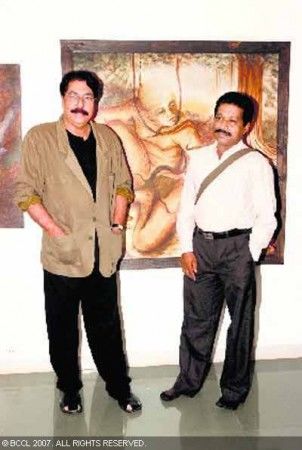
ABOUT MY WORKS
About my work
The familiar language of painting has landscape as a back ground for some context in the theme. Landscape is fragmented nature articulated compositionally to enhance the meaning of the context, or to contextualize an episode or even to give an atmosphere of scenic beauty. Nature as such has only a secondary existence in all such works from Renaissance period onwards or even in the miniatures. In India nature is more a motif than just a back ground in the painting and in the modern period it is almost like a referral point.
The greenery of the land, a sign of fertility is a generalized concept about nature. However each place has its own green/flora specificity. Even when nature is depicted the flora represented in the paintings is more connected with the ideologically acclaimed landscape with flowers like lotus and water lilies, trees such as mango trees or some other aristocratic ones.
In my paintings the locally specific flora and fauna almost envelops the whole canvas sometimes even eclipsing human presence. Only the tribals are projected as equal to nature, but in all other contexts nature is embraced wholeheartedly .Some of my works are leafy plant paintings with all the non aristocratic grass and papaya like plants.
Usually I use monochrome green to show the ethno-botanical nature of my native Kerala, so called God’s own country.
The green splendor of nature depicted is not just a landscape; it is the essence of the earth, the material plane of nature, children, butterflies, the very essence of Nature Being, an expression of green aesthetics.
Murali Nagapuzha

Article
Murali paints his strange but appealing pictures with great desire that people should love them. It is very difficult to gauge his painting in the traditional way because one constantly comes up against the unfamiliar and unexpected into his works. Take for example of his childhood series in which flying kids, flowers and butterflies create a dream like experience.
In some of his most recent works especially in Thirunelly series and in Sultans paradise and childhood dreams one can observe the trait of Rousseu. At the same time in total his painting carry and a sense of belonging and nostalgia to any unprejudiceal Kerala familiar viewers, let alone seasoned critics.
The real world is transformed by the artist’s imagination and have comes Muraly Nagapuzha. To recorded an object from memory could not be done by photography and so painting become meaningful. By drawing his attention to several sides of life and certain themes, Muraly finds himself a place in its historical setting. The interpretations offered to his art work result in the understanding of aesthetic analysis and artistic experience.
Overcoming the obsession with abstracts and phobia with ideology ,his brush strokes release resources for the emerging generation of art lovers. The biophysical and socio economic environment of kerala provides a magnetic aura that surrounds the paintings of Murali. He opens the eye of art lover to new frontiers of adventure , nature , fantasy, and facts of life. When contemporary art is vulgarized by facile repetition ,Muraly holds the secrets of life between his brush strokes with a spontaneous out flow questioning spirit.
Muraly Nagapuzha has grown up in a small village in India and there by making it natural part of him., he raises an eco conscious message . When sumptuous clouds, acid rains and automobile exhausts become the agonies of the eco system ,a vacuum engulfs our minds through the medium of oil on canvas by Muraly. The existing natural habitats , particularly the bio diversity at wyanad hill areas subjected to human interference are portrayed in a series .He has broken the rational circuit and has shown tribal women are beautiful too. Now we shall realize our own taste might not necessary be that someone in Europe.
From his minds private reserves ,deep emotions and dense colors flow out as a stream . Flaming colors and fading colors make it difficult for difficult for an analyst to set the parameters of his paintings. He feels more competent about his craft even though there are still the false starts and few discards. His straight forward and simplistic style must not be mistaken for a superficiality of art . He lacks the complexity that is often used denote the seriousness of art .With meticulous care he has introduced characters and engineered episodes in his painting s. Few of his paintings would be mysterious , mythological and fairy tales .Even though some his paintings are characterized by semi abstract elements , he doesn't slip into irrationalism or anti modernism .He hates the idea of being clubbed with faddist .
Muraly strikes a chord every where . May be it is the ecofriendliness of ever lasting humane trait . This versatile artist sum up his vision of the enlightened society in his fairy tale like Fantasy paintings where low order labors come in contact with surroundings which would soothe and elevate them . While parental compulsions are sacrificing the children's emotional needs, Muraly s paintings provide the opportunity to visualize all the elements that re appeared and re combine to remind us of our lost childhood . It seems that every hour Muraly dreams new dreams and if dreams come true he would not hesitate to to transform himself to infancy .
No other art form so prfectly suit to the time when the global market place is not concerned with social justice or environmental safety . Muraly is a magician with his strokes and a mature person with exceptional knowledge of social realities and people of his time .The more one sees and studies his paintings the more one appreciate the combination of realistic and aesthetical qualities of the artist. Let us believe in Muraly Nagapuzha . When he says , ‘’I HAVE A SENSITIVE AND CONSTRUCTIVE CONSCIENCE AND I HAVE DONE CERTAIN PAINTINGS WITH ELEMENTS THAT I AM ENTIRELY UN ABLE TO FORGET’’
Article
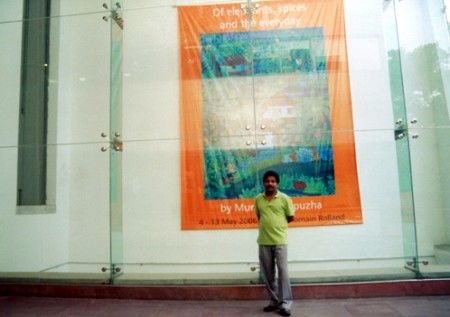
Reviews and comments
